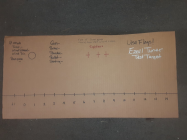I really find this to be pretty much just plain false, or at least opposite of my thoughts, experience and I have never found supportive evidence anywhere. Simply put, if anything at all(it's small) they become a bit less tune sensitive with a weight of some sort at the muzzle and there IS supportive evidence to that. You're simply doing two things. One is lowering vibrational frequency and the other is INCREASING amplitude. Yes, I know physics teaches us it lowers amplitude and yes, this is true OVER time, but it's not true in the very short period we are worried about in this context, of while the bullet is in the barrel. I've literally measured both and quantified exactly by how much as well with pretty fancy equipment and guys a lot smarter than me to set up and read the test. So it wasn't just me here. I'm just a dumb farmer/gun plumber but I've spent a ton on this very narrow subject, that being tuners and how they do what they do.
I do think that if a tuner is used for a crutch or if you're constantly fiddling with it, you're doing several things wrong with them. Bottom line, I tell people this, fwiw...don't touch the tuner unless you'd get up and change loads! You should also know by how much, which way and why, before you move it. Same for changing your load.
To the op, as others have said, yes, you're moving the tuner too far at a time. If this is a cf rifle, fire 15 three shot groups at 100 yards, moving the tuner only one line at a time. Your test target was similar to what I have people do, so I'm inclined to think you've spoken with someone on the subject but every tiny detail of my test tells me something. It's even very important the target be made just like what I describe and what a couple of others have posted a pic of. That test is freakin solid gold but it IS the shortcut. Skipping anything, pretty much means starting from scratch. That test is your instruction sheet, fired by you, with your rifle and load. Done right, it literally tells you everything you need to know. It shows tune at both top and bottom of the sine wave as well as what the gun does as it progresses away from tune and how far from extremes, in tune to all the way out. It also tells you which way to go as you see those specific and repeatable group shapes happen on your real match target.
I give very detailed instructions about all of this but only by phone because there are so many details and questions that I can help with only by phone. Mr Wass is on a very short list of people that I just wish all the best to in whatever he does but due to previous issues dealing with him, I'm just done with him.
I realize you're across the pond but I want to emphasize to you that I am very happy to help you with using my product. That's how I think business should be done, with great support, especially when it comes to tuners. So by all means, please do give me a call later this week when you and I can talk a bit. I'll be in and out some this week and I think things will be settled for the most part by about Wednesday or so. I'm on central time and my normal hours are typical business hours of 8am-5pm. I'll pm you with my number if you need me to or you may well have it since you have my product already...and thank you for that! I really don't believe anyone else comes close to the customer support that I'm happy to offer regarding tuners and I hope you will agree when we talk. Thank you again --Mike Ezell
PS--this is my test target with instructions. Every tiny detail, down to making your own target like it, matters.
Moving too far is THE most common mistake. It's easy to understand why too. I mean, we're starting with a blank sheet of paper here. But no matter whose tuner one uses, it's absolutely paramount to know the value of each incremental chang on the target. Without that, we'd all be guessing. I've done most of the legwork on mine in this regard and will explain..actually predict, specific group shapes and distance between sweet spots when we talk. G'Day!
 View attachment 1566012
View attachment 1566012











